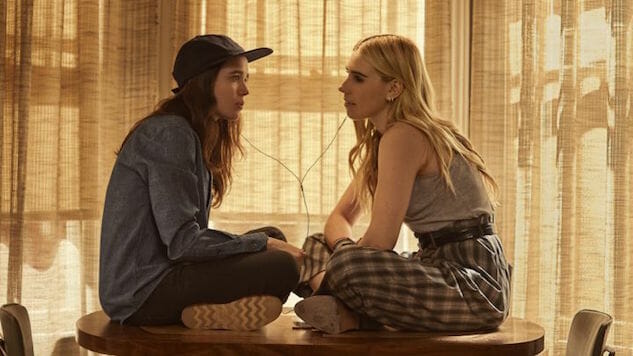Introducing Endless Mode: A New Games & Anime Site from Paste
Macondray Lane is a beautiful, tucked-away jewel of an alley in San Francisco’s Russian Hill. Only accessible on foot, it winds through staircase gardens and quirky but monied old houses. In the 1990s it became the inspiration for Barbary Lane, the fictional locale for Armistead Maupin’s Tales of the City. Netflix’s new adaptation of (or really, fantasia on) Maupin’s series is a riff that takes its own mysterious direction, but it honors the books’ characters, particularly linchpin-landlady Anna Madrigal (Olympia Dukakis) and uptight greenhorn Mary Ann Singleton (Laura Linney). The vibe is (for an update bent on respecting and reflecting contemporary social cues) strangely nostalgic, and that’s not a criticism. It works.
Several cast members are reprising their roles from the previous PBS adaptation of the books. For those of us who call mythic, precarious San Francisco home (I lived for many years a short walk from Macondray Lane) it wonderfully evokes a version of the city where everyone saw self-expression as a kind of Romantic quest, and where people could afford to live where they lived even if they were artists. Not everything in the series it feels totally authentic to San Francisco (there’s not enough dirt or background noise, and I laughed at a scene where Anna stays out late to look at the stars; in fact, everyone is just a little too comfortable outside without parkas) but the overall sensibility is right: a little constellation of people are bound together not by blood but by common values and a wagon-circling mentality in the face of external forces. There are tensions between the families we come from and the ones we choose, contending with the thornier internal tensions between who we are in our hearts and who we are in the eyes of the rest of the world.
The source material is not overwhelmingly deep, so it’s no surprise that the reboot has a certain surface-dwelling sensibility. It’s got enough plot to hold it together, but only just. Mary Ann Singleton comes back from Connecticut for Anna’s 90th birthday, and finds herself in a painful confrontation with the ex-husband and daughter Shawna (Ellen Page) who she left behind. Michael (Murray Bartlett) is navigating a relationship with a much younger man while dealing with the lingering ghosts of the AIDS crisis. A blackmail plot unfurls in the shadows. Brian (Paul Gross) has never really gotten over Mary Ann, but he finds her impossible to deal with, and so does Shawna. (Indeed so does most everyone, including her boozy art-patron friend Dede Halcyon-played by Barbara Garrick in a thinly-veiled portrayal of real-life SF socialite Dede Wilsey-who hilariously complains about the shifting definition of the term “queer,” remarking that “it’s like the price of oil.”)
Less-than-stellar elements include some of the more transparent moves to bring the story into the present. There is a well-acted but somewhat tediously conceived sub-story involving twins (Christopher Larkin and Ashley Park) on a quest to become Insta-famous. Mary Ann’s Connecticut uptightness is overplayed, not by Linney so much as by the script, and everyone’s reactions to her are annoyingly predictable. And I have to note that a truly contemporary rendering of the city would have a lot more pain erupting from socioeconomic stress in an area where the collapse of the city’s infrastructure and the ever-more-gaping chasm between rich and poor is felt by most people constantly: Maupin’s characters tend to float conveniently above it. In the real San Francisco, a safe harbor like 28 Barbary would have prompted riots, not genteel concern, if Anna Madrigal suddenly announced she was selling-those folks would have found themselves facing homelessness unless they were tech millionaires who could successfully handle a sudden 1000% increase in their rent. But that’s annoying more than it is a dealbreaker.
The series’ strengths include super solid acting all around; there is great chemistry in group scenes (a men’s dinner party takes a striking turn when Charlie Barnett’s 28-year-old Ben complains about the older guys’ catty and transphobic insults), as well as a deeply felt and interestingly articulated crisis for a young couple trying to stay together in the aftermath of one partner’s transition to male (May Hong and Garcia turn in some of the strongest performances in a super strong cast). It has a genuinely inclusive and celebratory character. It’s a lovingly composed panoramic photograph of SF queer culture. And, it’s a more-than-decent evocation of the thing about San Francisco: its still-unbelievable gravitational pull for people who, in whatever ways, don’t conform.
Tales of the City is now available on Netflix.
